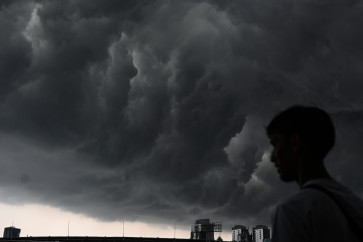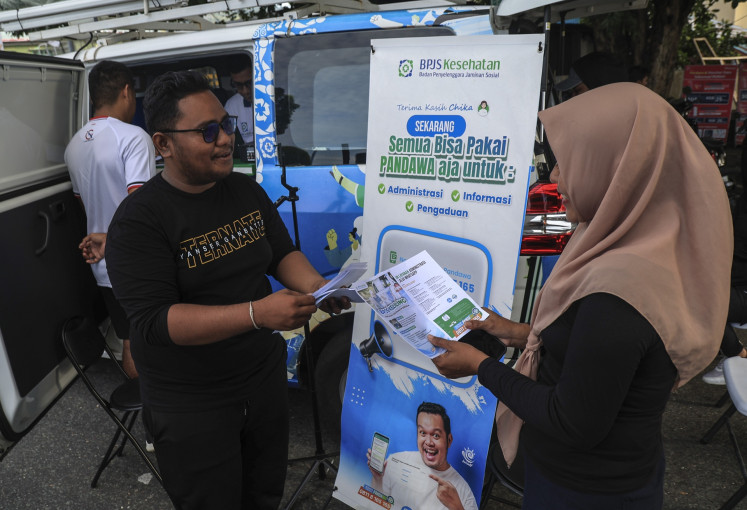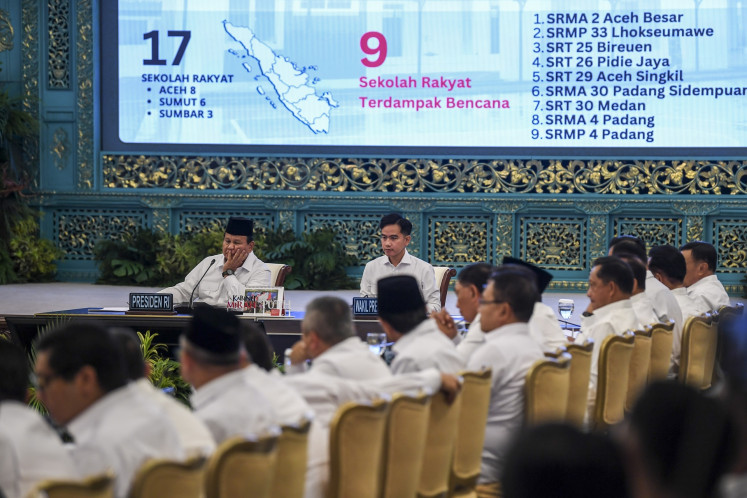Popular Reads
Top Results
Can't find what you're looking for?
View all search resultsPopular Reads
Top Results
Can't find what you're looking for?
View all search resultsJapan's MRT diplomacy
The MRT's daily ridership has consistently increased since it began operations on March 24, 2019, from 86,000 to 91,000 last year and 119,000 today.
Change text size
Gift Premium Articles
to Anyone
 A worker walks on May 7, 2024, at the end of the tunnel construction site in Jakarta with a tunnel boring machine for the Mass Rapid Transit (MRT) Phase 2 project, which will extend the current line to the north with loan funding
from the Japan International Cooperation Agency (JICA). (AFP/Yasuyoshi Chiba)
A worker walks on May 7, 2024, at the end of the tunnel construction site in Jakarta with a tunnel boring machine for the Mass Rapid Transit (MRT) Phase 2 project, which will extend the current line to the north with loan funding
from the Japan International Cooperation Agency (JICA). (AFP/Yasuyoshi Chiba)
J
apan has found consolation for its embarrassing loss to China in the race for the Whoosh high-speed railway (HSR) project in 2015. The Japanese-built Lebak Bulus-Bundaran Hotel Indonesia mass rapid transit (MRT) line has won over millions of passengers since it began operation in March 2019. On Monday, Japan's MRT diplomatic mission took things to the next level.
In 2015, Japanese people across the country were upset with President Joko "Jokowi" Widodo's choice of China over Japan for the HSR project, as they thought that the Japanese offer and feasibility study were better than China's. Then, during a meeting, then Japanese prime minister Shinzo Abe directly told President Jokowi that he was disappointed.
The Chinese-built Whoosh HSR from Jakarta to Bandung officially started operations last year, well behind the original schedule of 2019, with a swelling budget that forced the government to use taxpayer money to make up for the deficit.
Japan is now a step closer to realizing the government's ambition of connecting the Greater Jakarta (Jakarta, Bogor, Depok and Tangerang) area with MRT as the most feasible mass transportation option for the megapolitan area. It may take years to complete the project, but the public believes it will happen.
Such public trust is not surprising. Japan has always delivered on its commitments and promises, including to build modern modes of transportation.
Japanese Ambassador to Indonesia Masaki Yasushi and Indonesian Foreign Ministry Director General of Asia Pacific Abdul Kadir Jailani on Monday signed an exchange of notes between the two governments on the construction of the first phase of an east-west MRT line, which is worth 140.69 billion yen (US$ 903.4 million).
Japan's official development assistance (ODA) loan has an interest rate of 0.3 percent and a 40-year repayment period, including a 10-year grace period. This loan scheme is different from China’s, which uses a business-to-business arrangement. In the end, though, the Whoosh HSR loan ended up burdening on the state coffers.
The MRT project will go through multiple phases, with the first 33-kilometer line connecting Tomang in West Jakarta and Medan Satria in Bekasi. It will eventually be stretched 90 km to Balaraja in Banten and Cikarang in West Java, when completed in 2032.
The first phase will be divided into two steps. The first covers a 24.5 km line with construction starting in mid-2024, following the signing of an exchange of notes on a yen-denominated loan on Monday, which involved the Japan International Cooperation Agency (JICA).
The agreement falls under the Special Terms for Economic Partnership (STEP) program, meaning that Japanese firms will be directly involved in the project's construction, facilitating technology transfer to local partners. The technology transfer will focus on underground tunnel construction, train technology and signaling systems, which Indonesia will need to develop MRT systems outside of the Greater Jakarta area.
The MRT’s daily ridership has consistently increased since it began operations on March 24, 2019, from 86,000 to 91,000 last year and 119,000 today. The MRT operator said it has served over 102 million after five years of operation.
Many people will shift to the MRT when construction of the second phase of the North-South line between Jl, Thamrin and the old town Kota is completed in August 2027..
Japan, China and European countries have been fighting for railway projects, bullet trains or MRT systems in Southeast Asia and other Asian countries, including India. The competition concerns financial profits and expansion of their sphere of influence, especially in Asia. It turns out the rivalry is not just between the United States and China as many believe, but among various big economies.
Hopefully, the Greater Jakarta MRT project will face no meaningful hurdles and will be completed on schedule. We expect that Japan’s MRT diplomacy will attain its objective, which are mutual benefits for the people of the two countries.










